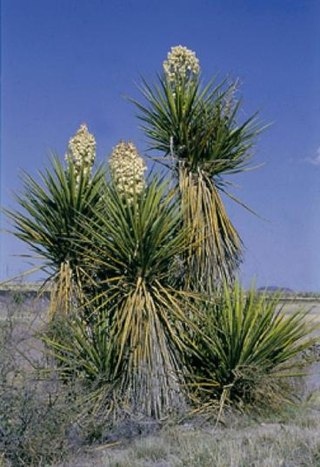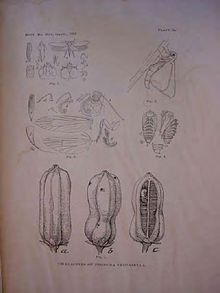
Yucca is a genus of perennial shrubs and trees in the family Asparagaceae, subfamily Agavoideae. Its 40–50 species are notable for their rosettes of evergreen, tough, sword-shaped leaves and large terminal panicles of white or whitish flowers. They are native to the Americas and the Caribbean in a wide range of habitats, from humid rainforest and wet subtropical ecosystems to the hot and dry (arid) deserts and savanna.

Yucca brevifolia is a plant species belonging to the genus Yucca. It is tree-like in habit, which is reflected in its common names.
The Prodoxidae are a family of moths, generally small in size and nondescript in appearance. They include species of moderate pest status, such as the currant shoot borer, and others of considerable ecological and evolutionary interest, such as various species of "yucca moths".

Yucca filamentosa, Adam's needle and thread, is a species of flowering plant in the family Asparagaceae native to the southeastern United States. Growing to 3 metres tall, it is an evergreen shrub valued in horticulture.

Tegeticula is a genus of moths of the family Prodoxidae, one of three genera known as yucca moths; they are mutualistic pollinators of various Yucca and Hesperoyucca species.

Yucca glauca is a species of perennial evergreen plant, adapted to xeric (dry) growth conditions. It is also known as small soapweed, soapweed yucca, Spanish bayonet, and Great Plains yucca.

Yucca faxoniana is a bladed evergreen shrub of the genus Yucca. It is known by the common names Faxon yucca,Spanish dagger, and giant dagger.

Prodoxus is a genus of moths of the family Prodoxidae. The members of this genus are known as bogus yucca moths.
Tegeticula californica is a moth of the family Prodoxidae. It is found along the coast of southernmost California, United States.
Tegeticula tehuacana is a moth of the family Prodoxidae. It is found in Mexico in Oaxaca, western- and south-western Veracruz, and central-northern Puebla centred on the Tehuacan Valley.
Tegeticula tambasi is a moth of the family Prodoxidae. It is found in Mexico from northern central San Luis Potosí south-east to Querétaro, and south-westward beyond Morelia, Michoacán.
Tegeticula baja is a moth of the family Prodoxidae. It is found in Mexico on the Baja California Peninsula.
Tegeticula intermedia is a moth of the family Prodoxidae. Along with other moth species, it is commonly known as a yucca moth. T. intermedia lives in North America, particularly the United States. The moth resides in the southwest, the Great Plains, the Southeast, and mid-Atlantic. It also has been found much farther north in regions of Canada like Ontario and Alberta. There are also notable populations present in New Mexico. Their habitats are diverse and vary in terms of climate, landscape, and other factors. The moth lives in sand dunes, forests, glades, grassland, desert, and forests from the East Coast to the Southwest. Yucca moths have developed a strong mutualism with the yucca plant, such that both depend on each other for survival. The yucca moths and yucca plants have coevolved over millions of years. However, Tegeticula intermedia differs from most yucca moths in that it exhibits cheating behavior by laying eggs without pollinating the yucca plant.
Tegeticula corruptrix is a moth of the family Prodoxidae. It is found in North America in south-western California, Arizona, New Mexico, northern Coahuila, western and southern Texas, Colorado, Alberta, the western plains of Nebraska, Wyoming and Montana.
Tegeticula cassandra is a moth of the family Prodoxidae. It is found in the United States in north-central Florida and bordering areas of Georgia. The habitat consists of open pine and pine-oak forests and open grassy areas with oak scrub.
Prodoxus praedictus is a moth of the family Prodoxidae. It is found in the United States in the southern part of the Mojave Desert and bordering areas of the Colorado Desert, as well as in the central portion of the Joshua Tree National Park in California.
Prodoxus tehuacanensis is a moth of the family Prodoxidae. It is found in Mexico in the Tehuacán-Cuicatlán region of Puebla and Oaxaca.
Tegeticula antithetica is a species of moth in the family Prodoxidae. It is found in the Mojave Desert of the North American southwest, specifically southern California, southern Nevada, southwestern Utah, and western Arizona.

Yucca arkansana, the Arkansas yucca, is a plant in the family Asparagaceae, native to Texas, Oklahoma, Arkansas, Missouri and Kansas. It generally grows in gravelly, sunlit locations such as rocky outcrops, prairies, etc. It is not considered to be threatened.
The host sanction (HS) theory aims to understand how cooperation evolves and is maintained in a mutualistic relationship between organisms. The host sanction model theorizes that the host organism of a mutualism is able to decrease the fitness of the other organism to prevent cheating.








